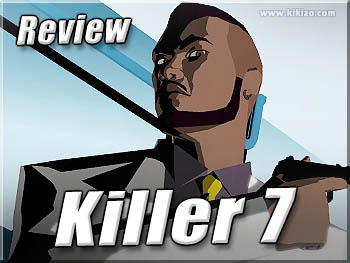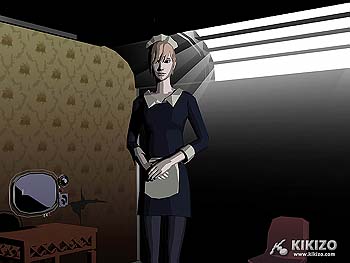Killer 7
It's a game of Good vs. Evil, political intrigue, blood, schizophrenia and Mexican wrestlers. Perhaps someone at Capcom has been on the happy juice?
| Version PS2, GCN | Developer Capcom | Publisher Capcom | Genre Action |
||||
"Free the Capcom 5! Free the Capcom 5!" chants the crowd of hungry gamers outside Capcom HQ. "We already have...!" squeaks the timid developer, "...apart from that whole incident with the unerringly named Dead Phoenix, which we'd prefer to not talk about, they're all out now". "Oh, right you are then; thanks, bye." mumbles the crowd as it toddles off home to play. P.N.03, Viewtiful Joe, Resident Evil 4 and now, finally, Killer 7.

A brave and wonderful experiment by one of the worlds most respected developer/publishers that has critically, if perhaps not commercially, been an enormous success. Style and substance appears to be the common factor among these games, that and mixing the old with the new. There is no doubting the brilliance of Resi 4, the sheer viewty of VJ and, er, something about the other game, but now we've arrived at the end, how has the last of the Capcom 5 fared?
For a start, Killer 7 is easily one of the hardest games we've ever had to review; even on the surface it aims to test what a videogame can be, but underneath it all is something which pushes back the boundaries of gaming. It is also easily one of the most adult-oriented games we've ever seen, and as such this review shall reflect that. Most people have some idea of what Killer 7 is, or at least what they think it is. They've seen the graphics and categorised them as 'cel-shaded', lumping it in with other games with a similar visual presentation. They've heard about the quirky control method, seemingly made odd just for the sake of being different. They've read that the plot revolves around that of a hitman with multiple personalities. None of these things tell you what Killer 7 actually is though. Killer 7 is not just a game; it is an 'experience'.
Writing this review still isn't getting any easier, so we'd best break it down into smaller, more manageable chunks. We'll start with those three well known points and the rationale behind them. On a merely superficial level, this game is stunning beautiful; the graphics are not your garden variety cel-shading, and are certainly not rendered as such to jump on any bandwagons. The starkness and lack of detail in the environment is there to highlight the sense of 'unreality' embedded in the story, and to bring focus to the characters and their violence. Two things to note: yes, the plot in this game is an incredibly important aspect of the game, indeed the single most important part of the Killer 7 experience and the one that will most influence your enjoyment of it; and yes, this game is extremely violent.
Before we incite a hoard of salivating teenagers into desiring this game though, it must be said that the number of people whom will actually garner any gratification from playing this game will likely be very low. Personally, whilst the complete experience was entertaining, it was not particularly fun, per se. Please, if comedy deaths, sweary characters and mild titillation are your bag (and there's absolutely nothing wrong with that, indeed Killer 7 contains such elements), just stick to bugging your parents for GTA as it's very unlikely you'll enjoy Killer 7. This is in no way intended as condescension nor molly-coddling, it is a simple statement of fact.
The violence is more than just simple blood and guts (even so far that blood itself is the games currency, used for upgrading character skills and performing special moves). There is a cruelty and malevolence in many of the games' violent acts that, more than any other 18-rated game ('Mature' in the US), means it should not under any circumstance be played by minors. Indeed, a probable secondary reasoning for the graphical approach is to ensure the game even got that 18 rating, as if it were rendered in a more real-world styling, particularly in the current political climate of the US, it is likely it would be banned outright.
To illustrate, certain plot points cover child abuse, terrorism, political/religious extremism and to ram it home the whole concept of the enemy Smiles is nothing less than a stylised portrayal of suicide bombers. Additionally, the game is already been attacked by the game industries current most well-known legal nemesis, Jack Thompson, based on claims of "full blown sex sequences". True, there are depictions of sex in the game, but they are handled tastefully, are relevant to the story and are in no way gratuitous.
Phew, that was only the first point; next up is that control method. In terms of structure the game shares much in common with the rest of the survival horror genre: run around, shoot enemies, collect items and solve simple puzzles to progress. With Killer 7 though, you don't have direct control of exactly where your character moves, rather they move along a pre-defined path which leads you to where you need to be. You hold down one button to move forward and press another to change your direction, whilst the right analogue stick selects which path you take when you reach a junction. Then, when you hear an enemy Smile nearby, another button switches you to a first person view so that you can line up your crosshairs and shoot them in their 'proverbials' (that is, a highlighted weak spot).
The overall feeling is closer to that of a bastard son of Dragon's Lair and Time Crisis, though nowhere near as bad as that sounds. It doesn't take long for it to become second nature and in many ways feels quite refreshing. Capcom seems to have a knack for clunky control mechanism, supposedly to enhance the players attachment to their on-screen avatar, and in this case that would apply to an imposed feeling of being controlled versus freedom of choice, an element that reflects much of the story's meaning.
Now for the third of those points; the plot. The story behind this game challenges the player in similar ways to those of a David Lynch film, being told on many different levels at the same time, all mixed together and distorted over time and space. Then add to that the use of certain storytelling devices and concepts not usually seen in western media, and that should give you a fair idea of how complex it all is. The multiple personalities of the main character are, again on the superficial level, a simple device for varying the gameplay. Each of the Killer 7 wields a different weapon and set of skills to aid in fighting certain enemy types and solving puzzles. However, the way main character Garcian Smith interacts with the other 6 members, and in turn with his supposed boss Harman Smith, provides some small clue as to just what the hell is going on.
There is little in the way of explanation or back-story and as such, it is wholly up to the player to understand. Multiple playthroughs are recommended to better understand exactly what was going on, and perhaps discussions with other fans wouldn't go amiss either. Despite stating earlier about there being a lack of 'fun', there are some great moments of dark humour to be found, these mainly coming from the 'ghosts' of those killed by (or near) the extended Smith family. These characters are voiced in a strange synthesised garble, which may eventually grate for some players, but which add much to the experience. Particular favourites are Susie the disembodied head who has some serious men issues and ends every sentence with a 'smiley' (*^_^*), and Iwazaru the subservient, gimp-suited weirdo who acts as a mobile glossary and hint giver.
We don't want to start being pretentious and refer to Killer 7 as art; it isn't (at least no more than any other game, book or film). This is above all else still a game, and as such must be viewed as such. As a game it has great style in its presentation, both visually and aurally, and the substance is solid, though aside from the initially quirky control method, fairly unoriginal. In those aspects it isn't greater than the sum of its parts, but is enjoyable nonetheless. But if storytelling is an element you want to receive from the games you play, and you are prepared to put in the effort required to understand it, then you should receive much pleasure from the Killer 7 experience.
| ||||||||||||
|
| Video Coverage (Latest Videos & Video FAQ) | |||
| PLEASE DO NOT DIRECT LINK TO ANY MEDIA FILE ON KIKIZO | |||
| Description | Dur. | Size | Details |
|
Killer 7 Trailer (Capcom) |
1.20m | 13MB | DF, SD, 30 640x480 1.5Mbps |
|
Killer 7 Gameplay footage (Capcom) |
0.36m | 6MB | DFA, SD, 30 640x480 1.5Mbps |
|
Killer 7 Fantastic trailer (Capcom) |
2.56m | 21.9MB | DF, SD, 30 480x360 1.8Mbps |






























 Satoru Iwata Video Interview - the late Nintendo president spoke with Kikizo in 2004 as 'Nintendo Revolution' loomed.
Satoru Iwata Video Interview - the late Nintendo president spoke with Kikizo in 2004 as 'Nintendo Revolution' loomed. Kaz Hirai Video Interview - the first of Kikizo's interviews with the man who went on to become global head of Sony.
Kaz Hirai Video Interview - the first of Kikizo's interviews with the man who went on to become global head of Sony. Ed Fries Video Interview - one of Xbox's founders discusses an epic journey from Excel to Xbox.
Ed Fries Video Interview - one of Xbox's founders discusses an epic journey from Excel to Xbox. Yu Suzuki, the Kikizo Interview - we spend time with one of gaming's most revered creators.
Yu Suzuki, the Kikizo Interview - we spend time with one of gaming's most revered creators. Tetris - The Making of an Icon: Alexey Pajitnov and Henk Rogers reveal the fascinating story behind Tetris
Tetris - The Making of an Icon: Alexey Pajitnov and Henk Rogers reveal the fascinating story behind Tetris Rare founders, Chris and Tim Stamper - their only interview? Genuinely 'rare' sit down with founders of the legendary studio.
Rare founders, Chris and Tim Stamper - their only interview? Genuinely 'rare' sit down with founders of the legendary studio. The History of First-Person Shooters - a retrospective, from Maze War to Modern Warfare
The History of First-Person Shooters - a retrospective, from Maze War to Modern Warfare